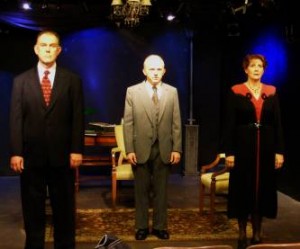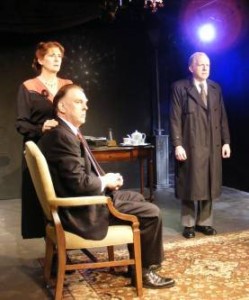
There’s a moment early on in Michael Frayn’s Tony Award-winning Copenhagen when Margrethe Bohr says reassuringly to her physicist husband Niels, “I don’t think anyone has yet discovered a way you can use theoretical physics to kill people.” Ironic words indeed when spoken to one of the theoretical physicists who worked on the Manhattan Project developing the atomic bombs dropped on Hiroshima and Nagasaki, weapons which led to the immediate or eventual deaths of 200,000 human beings.
It is this irony, scientific theory turned murder weapon and scientific theoreticians turned killers, that for this reviewer at least is the core fascination of Frayn’s dense, difficult, gripping, and infinitely rewarding play, now being given an absolutely splendid production under the brilliant direction of August Viverito at The Production Company’s Chandler Studio Theatre in North Hollywood.
I wasn’t always a Copenhagen fan. When the 2001 tour played the Wilshire Theatre, I ended up leaving at intermission. Whether it was the time of the day, or the distance of my seat from the stage, or simply my own unpreparedness, I just didn’t get what all the fuss was about.
How wrong I was.
As with Shakespeare, it helps to arrive at a performance of Copenhagen prepared. I suggest Googling an article or two on either the play, or the scientists in question, or both. It’s well worth the investment.
Copenhagen takes place in the past and in the afterlife, as its three characters, Danish physicist Bohr (David Ross Paterson), his wife Margrethe (Sarah Lilly), and Bohr’s younger German counterpart Werner Heisenberg (Skip Pipo) recall and debate Heisenberg’s fateful visit to the Copenhagen home of his old friend/father figure/mentor in October of 1941. Their outdoor walk (Borh’s house being bugged by the Nazis) lasted all of ten minutes, but has been speculated about ever since. Could this walk (which ended with an angry Bohr sending Heisenberg on his way) have actually altered the result of World War II? Had things gone differently, had different words been spoken, had one of them reacted less impulsively, would it have been London, Paris, Amsterdam, and perhaps even Copenhagen wiped out by the atom bomb, leading to who knows what consequences?
If ever a play could be called thought provoking, it is Copenhagen. Who was the more moral of the two scientists, the one who helped develop the bomb that brought about a peace treaty with Japan or the one who may have discouraged the Germans from doing the intense research and development that could well have led to a Nazi victory and its subsequent horrors? How is it possible that breakthroughs in theoretical science such as Bohr’s and Heisenberg’s discoveries in quantum physics could lead to potentially earth-annihilating weapons? How can one tiny moment in time alter the course of the world forever?
Frayn uses the language and concepts of physics (Heisenberg’s uncertainty principle, Bohr’s principle of complementarity) as metaphors for the behavior of his three characters in ways that may occasionally go over the spectator’s head, yet fascinate nonetheless.
Viverito’s direction is nothing short of dazzling, especially when one considers that Frayn’s play is entirely made up of dialog. Not a single bit of stage direction. Not a single description of how the stage should be set. Not a single note for the actors. Everything we see on stage at the Chandler is entirely Viverito’s conception and execution, not just as director but as production designer as well. His characters’ stage movements often resemble the movements of the subatomic particles they are describing. His stage setting—three downstage chairs arranged like three sides of a square, with a desk and desk lamp upstage—is simple but works to perfection. Lighting shifts cue us as to where we are in time, occasionally featuring two different patterns occurring simultaneously as, for example, when Bohr and Heisenberg are in the past while Margrethe is in the limbo zone of memory. Bohr and Margrethe are often bathed in warm light with Heisenberg lit with Teutonic chill. There’s one particularly striking lighting effect late in Act Two that is truly devastating in its ability to shock and horrify.
Paterson is perfection as Bohr, a man of science and a man of humanity, a loving husband, a still grieving father, a complex mix of characteristics that in Paterson’s multishaded performance hold the audience spellbound.
Pipo disappears into Heisenberg’s methodical skin, alternately charming and distant, winning and a bit off-putting, and Viverito’s decision to have him speak with a faint German accent (he didn’t in the Broadway original) reminds us that Heisenberg is indeed a foreigner to Bohr and Margrethe, whose accents are vaguely British.
Lilly gives us a Margrethe whose warmth, pluck, and loyalty to her husband and country conceal an anger that shocks us when it is finally unleashed. Only words stumbled over here and there take us out of the moment and remind us that we are hearing memorized lines, perhaps a result of nearly a week off since the actress’s previous performance.
Copenhagen has been assistant directed by T L Kolman with dramaturgy by Kelly Lloyd.
Due to scheduling conflicts, I very nearly missed this production of Copenhagen. I’m not sure if the chain reaction which a postponed Opening Night set about (and which led to my availability to see Copenhagen) illustrates any of Bohr’s or Heisenberg’s principles. What I do know is that it was indeed fortuitous. I wouldn’t have wanted to miss this superb production for the world!
The Production Company, Chandler Studio Theatre, 12443 Chandler Blvd., North Hollywood.
www.theprodco.com
–Steven Stanley
May 7, 2010
Photos: The Production Company




 Since 2007, Steven Stanley's StageSceneLA.com has spotlighted the best in Southern California theater via reviews, interviews, and its annual StageSceneLA Scenies.
Since 2007, Steven Stanley's StageSceneLA.com has spotlighted the best in Southern California theater via reviews, interviews, and its annual StageSceneLA Scenies.







 COPYRIGHT 2024 STEVEN STANLEY :: DESIGN BY
COPYRIGHT 2024 STEVEN STANLEY :: DESIGN BY